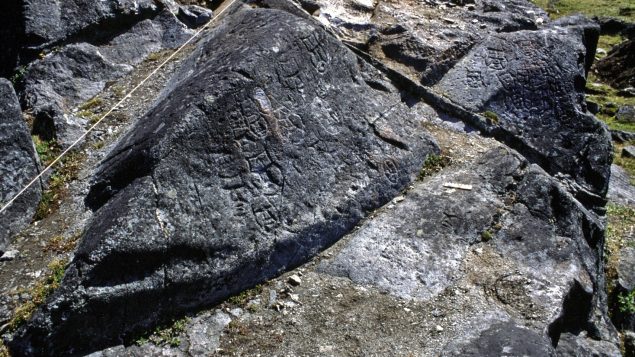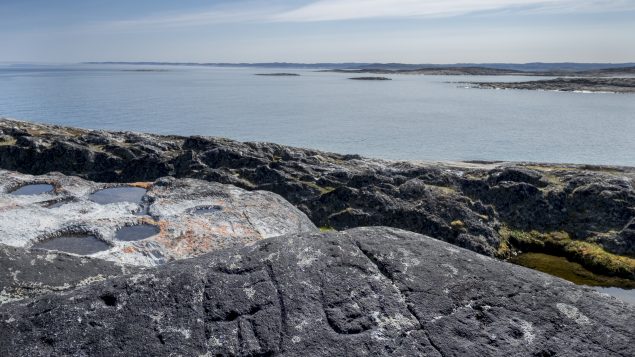Their exact location is a jealously guarded secret but a set of mysterious petroglyphs in the Eastern Canadian Arctic feature among Ottawa’s latest submission to the United Nations Educational, Scientific and Cultural Organization (UNESCO) for consideration as a new World Heritage Site.
The so-called Qajartalik petroglyphs, highly stylized human faces carved into soapstone, are unique manifestations of Dorset Era artistic expression, said Louis Gagnon, a curator with the Avataq Cultural Institute, a non-profit group dedicated to protecting and promoting Indigenous language and culture in the Eastern Arctic.
(click to listen to the interview with Louis Gagnon)
ListenQajartalik appears to be the only place where Dorset Era peoples transposed onto soapstone, on a huge scale, the distinctive figures usually found on much smaller artifacts made of bone, ivory or horn, Gagnon said.
The Dorset people lived along the coasts of Nunavik from 2,000 to 1,000 years ago and disappeared before the arrival of the Thule Inuit, the ancestors of the modern Inuit inhabiting the area, approximately 800 years ago, Gagnon said.
Qajartalik, which means “the place where a kayak can be seen” in Inuktitut, is officially part of Canadian Arctic territory of Nunavut, but because it lies off the coast of the Inuit region of Nunavik in northern Quebec it is used by the Nunavik Inuit, said Gagnon.
While the Inuit – and the Dorset people before them – have used the island for centuries to quarry soapstone for their oil lamps and cooking pots, Bernard Saladin d’Anglure became the first Westerner to document 95 carvings at Qajartalik in the early 1960s.
During later expeditions to Qajartalik from 1996 to 1998 he discovered and documented an additional 70 petroglyphs, bringing the site’s total to 165. More carvings have been found since.
‘Unique Arctic rock-art’

For the last decade, the Avataq Cultural Institute has been working with the federal government to have Qajartalik recognized as a world heritage site. (Louis Gagnon /Avataq)
The carvings, which have baffled archaeologists since their discovery in the early 1960s, range from a few centimetres in height to more than 30 centimetres, Gagnon said.
Qajartalik is not only the most northerly rock-art site on the continent; it is also one of a kind because it depicts only these stylized faces and nothing else, he said.
The faces are highly anthropomorphic and come in various forms: rounded, oval, square or triangular. Many have horn-like features on top of their heads.
“It’s probably why some people were talking about, ‘Oh, they are devil representations,’” Gagnon said. “Maybe, but this is a modern interpretation.”
However, the pointy features on the top of the carved heads could also represent a particular Dorset Era article of clothing, Gagnon said.
Dorset people wore parkas with very high collars, almost reaching the top of the head of a person, instead of the hoods preferred by the Inuit, Gagnon said.
“So maybe it’s just a representation of those two points coming from the collar,” Gagnon said. “We did some experiments and it looks pretty much the same.”
Scientists have been unable to date the site very precisely but experts believe the extinct Dorset culture created the carvings about 1,000 years ago, .
Scientists speculate that the decline of the Dorset people was triggered by a sudden warming of the climate in the Arctic around the 10th century. The Dorset people had a hard time coping with dramatic changes in their environment and that precipitated an increase in magical beliefs and shamanism, as well as artistic expression related to these spiritual practices, Gagnon said.
“It’s an indication maybe that that site, which is quite unique with all those faces, could be a sort of an attempt to make some sort of a ritual or something linked to shamanism,” Gagnon said.







For reasons beyond our control, and for an undetermined period of time, our comment section is now closed. However, our social networks remain open to your contributions.